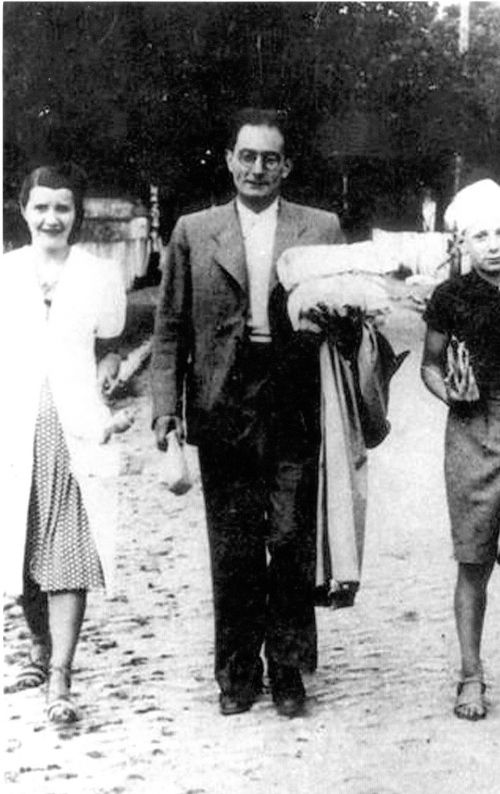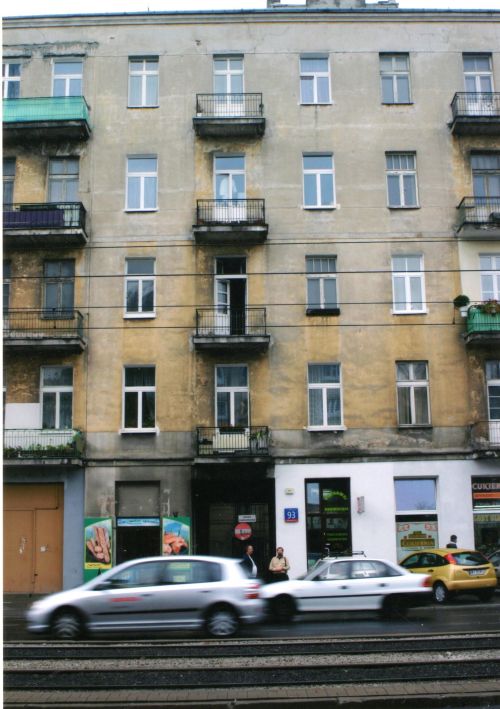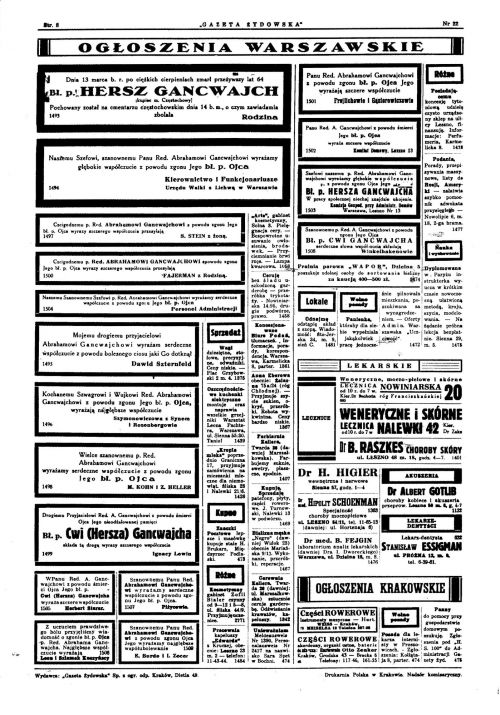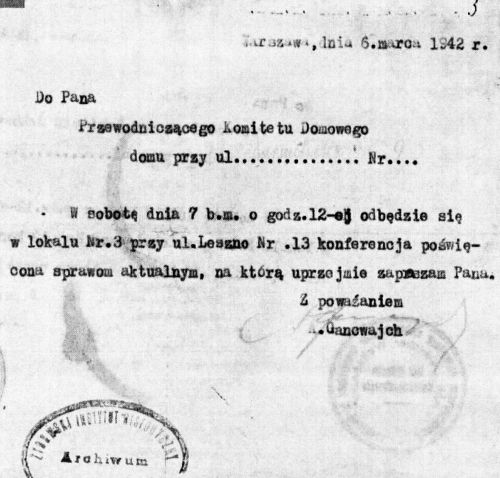The 'Thirteen' in Warsaw - Headed by Abraham Gancwajch

Abraham Gancwajch and his family
Abraham Gancwajch was born during 1904, in Czestochowa, Poland and he received a traditional education including rabbinic ordination. In 1938, he left Vienna, Austria, and settled in Lodz, Poland, where he published a weekly journal combatting anti-Semitism. After the Germans occupied the city they arrested the weekly subscribers, but left Gancwajch untouched.
At the beginning of 1940, Gancwajch moved to Warsaw, where he would appear at meetings and conventions for refugees, where he would speak of the rising power of the Germans and the call for non-opposition to it. Gancwajch won the trust of key figures within the German occupation authorities. Gancwajch himself claimed that his privileged position grew from a recommendation from a relative, Moshe Merin, who was chairman of the Judenrat in Zaglebie. Other sources claim that Gancwajch was favoured due to his pre-war friendship with Dr. Olenbusch, who was in charge of the Propaganda Office in Warsaw. Through the support of the German Security Services (SD) in Warsaw Gancwajch established an agency known as the 'Thirteen' (Trzynastka in Polish and Das Draitzental in Yiddish) which took its name from the address of its headquarters at Leszno Street 13.

Leszno Street -13 - September 2005
The principal division of the 'Thirteen' network, which was founded in December 1940, was the Office to Combat Usury and Profiteering in the Jewish Quarter of Warsaw' and a supervisory unit was also established, parallel to the Jewish Order Service maintained by the Judenrat. Its personnel wore polished boots, caps with a green band, rather than the blue ones worn by the regular police, epaulets and stars to denote rank. The ranks of the 'Thirteen' swelled to some three to four hundred men. In May 1941, Gancwajch established 'First Aid' a kind of Red Cross emergency station, whose ambulance was used for smuggling and other commercial operations.
The Office to Combat Usury and Profiteering had broadly defined powers. It was supposedly established to supervise weights and measures in the Warsaw Ghetto bakeries and to prevent the production of goods that were considered luxuries, such as rolls made with white flour, but the main thrust of their activities was to bully and blackmail people.
During a certain period two more refugees from Lodz, Moryc Kohn and Zelig Heller, joined Gancwajch, but soon broke away, to form other enterprises, including the horse-drawn wooden trolleys that transported passengers within the ghetto. Gancwajch became known as a man of great influence and power, he was able to get prisoners released, obtain permits, move in and out of the ghetto, transfer people into the ghetto. Gancwajch services were in great demand, but came at a heavy price.Gancwajch was a skilled orator, whose speeches were clothed in the rhetoric of public spirit. The Judenrat under the leadership of Adam Czerniakow were locked in a bitter struggle with Gancwajch and the 'Thirteen.' Gancwajch saw himself replacing Czerniakow as Chairman of the Judenrat. Other key figures in the 'Thirteen' were vice-Director, David Szternfeld and Ignacy Lewin, who both feature in the following extract along with Kohn and Heller:

Funeral Notice for Hersz Gancwajch, the father of Abraham Gancwajch - Gazetta Zydowska
However, it was not to be, in July 1941, despite the efforts of Dr. Ernst Kah, Director of Department III, of the German Security Police in Warsaw, Heinz Auerswald, the German Kommisar of the Ghetto closed down the Office to Combat Usury and Profiteering, probably in a bid to limit the SD's influence within the ghetto. The 'Thirteen' did not vanish completely after this setback, they concentrated their efforts on the 'First Aid,' initiative.
On the night of April 18, 1942, the Germans carried out a massacre in the Warsaw ghetto, known as 'The Night of Blood,' or the 'Bartholomew's Night.' German trucks entered the ghetto after dark and armed SS troops dismounted , accompanied by Jewish policemen acting as guides, then made for addresses on their lists. Those on the wanted list were dragged out of their beds into the streets and murdered by a shot in the back. Of the sixty people on the list, fifty-two were killed. The two top men in the 'Thirteen' organisation, Abraham Gancwajch and David Szternfeld were apparently on the list, but they managed to escape before the murder squads arrived. In the Warsaw ghetto he lived at Twarda Street, 27.

Gancwajch Invitation 1942
After his popularity with the German authorities waned Abraham Gancwajch hid outside the ghetto in the Aryan part of Warsaw. Abraham Gancwajch was probably shot in Pawiak prison with his wife and son during April 1943. This was a few months after David Szternfeld had been murdered by the Germans on Smocza Street in the Aryan part of Warsaw, in January 1943, he had been working for the Gestapo on the Aryan part of Warsaw, shadowing and betraying Jews who had fled from the ghetto.
Sources:
Sources:
Yisrael Gutman, The Jews of Warsaw 1939-43, The Harvester Press, Brighton 1982
The Warsaw Diary of Adam Czerniakow, Elephant Paperbacks, Chicago 1999
Abraham Lewin - A Cup of Tears – A Diary of the Warsaw Ghetto
The Stroop Report, Secker and Warburg Limited 1979
Encyclopedia of the Holocaust
Stanislaw Adler - In the Warsaw Ghetto, Yad Vashem, Jerusalem 1982
Warsaw Ghetto Database -online resource
Photographs: Private Archive and Chris Webb Private Archive
Gazetta Zydowska
Centralna Biblioteka Judaistyczna - (ZIH) Waraaw, Poland
© Holocaust Historical Society 2019

